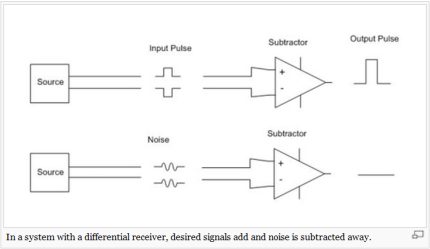Here are some really important Ethernet Cabling Installation Tips!
- For solid wire UTP, the minimum bend radius is eight times the outside diameter of the cable. Anything less affects the twist rate, reducing noise rejection.
- When installing long runs be careful not to stretch the cable, doing so could alter the twist rate, again reducing noise rejections.
- Due to the high frequency of digital transmissions, the phenomenon of skin effect comes into play. So be careful not to nick the copper wire.
- Make sure to use plenum-rated Ethernet cabling, if the run is located in a space that is used for air circulation.
- Run Ethernet cabling at least 15 cm from any high-voltage lines, 30 cm is better.
- If Ethernet cabling must cross a high-voltage line, do so at a 90 degree angle.
To understand why Ethernet cable is built the way it is, it requires familiarity with how the signals are transmitted over the wires. The fancy term is differential signaling. During a digital pulse, each wire in the pair carries a signal that is the same voltage, but opposite polarity. The slide below (courtesy of Wikipedia) exemplifies the process:
The greater the difference between the input pulses, the larger the output pulse, making it easier for the receiver logic to differentiate ones and zeros. I might add that this becomes more important as throughput rates increase.
As you can see in the slide, differential signaling has some noise-canceling capability, but not enough when it comes to Ethernet cabling. That’s because two types of interference come into play, electromagnetic radiation from sources such as power wires or crosstalk from other pairs in the same cable. Both introduce noise that reduces the differential. If there is enough noise, the receiver can misread what was sent.
The Ethernet cabling most of us are familiar with consists of four pairs of wires, twisted together, and enclosed in a single insulating cover jacket. Those twists are a pain when making connections, but are there for a reason. Transmitting Ethernet signals over a cable that small would not be possible without them.
To understand the importance of twisting the wires requires learning about common-mode rejection. It seems that digital electronics connected with balanced lines, such as twisted pair Ethernet cabling are capable of rejecting noise, as long as the spurious emission is common to both leads in the twisted pair.
It might help to use an example. I mentioned crosstalk earlier. If pairs were not twisted in Ethernet cabling, it is entirely possible for two wires in adjacent pairs to be next to each other for the entire length of the cable. That could skew the results by adding cross talk to only one leg of the pairing.
If the wires in the pair were twisted, both wires in the pair would be affected the same. Then the receiver using common-mode rejection would be able to filter out the crosstalk interference.
This phenomenon was discovered by Alexander Graham Bell. In fact, telegraph wires were the first twisted pair. The wires switched position on the pole after a certain distance (courtesy of Wikipedia):
Ever notice that some of the twisted pairs are easier to un-ravel? There is a reason for that. If adjacent pairs have an equivalent twist rate or pitch, the same wires of each pair could be next to each other for the entire run, negating differential signaling. In order to prevent that, Ethernet cable manufacturers use different twist rates (courtesy of Wikipedia):
According to cabling best practices, pair wires should not be untwisted more than 13 mm. This comes into play when using punch-down blocks.
There are two types of Ethernet cabling, Unshielded Twisted Pair (UTP) and Shielded Twisted Pair (STP). STP cabling is used if there is an abnormal amount of electromagnetic interference. STP uses metal-foil shielding that directs any external noise to ground. The metal foil can surround each twisted pair (STP), all the twisted pairs S/UTP), or both (S/STP).
Hope this helps.
I hope you find this article and its content helpful. Comments are welcomed below. If you would like to see more articles like this, please support us by clicking the patron link where you will receive free bonus access to courses and more, or simply buying us a cup of coffee!, and all comments are welcome!




